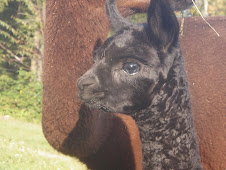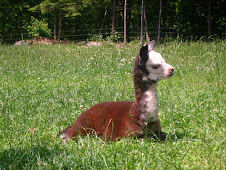Thursday, March 11, 2010
Taking Care of the Rumen
We’ve all experienced it at some point - some major stress in our life or we’ve altered our diet less than gradually or taken medication or something as simple as drinking different water while on vacation and it results in serious digestive upset! Well, alpacas are just as susceptible or more so to gastrointestinal upset than we are. While discussing alpaca digestion can be quite involved, I’ll attempt to offer a few simple ways to ward off potential problems.
Digestive Flora
Scientists estimate that we humans have trillions of microbes (bacteria, viruses, fungi and assorted parasites) living on the outside of our body and hundreds of millions in our digestive tract. Our bodies coexist with these living microscopic organisms, keeping us healthy most of the time and helping us digest and absorb vitamins and minerals from our food and water. These microorganisms (bacteria, protozoa, fungi, etc) are also teaming within the alpaca.
The population dynamics of the different species found in the forestomach will depend on the alpaca’s diet. This brings me to my first Tip: Avoid abruptly changing the diet for exactly this reason – the microorganisms are specific to the diet. If you change the diet abruptly the alpaca now has a population that is designed to serve a different diet and they can wreak havoc while simultaneously the forestomach has no population of the microorganisms to work with the new diet. This results in stress and a gastrointestinal challenge for the animal.
Stress
Stress impacts all the physiological systems including gastrointestinal function and health. Stresses such as: too much heat or cold; too much, too little or the wrong kind of food; aggressive companions or crowded conditions or transport and shows can lead to digestive tract problems such as colic, constipation, urinary tract problems, parasite problems, ulcers and so on. These range in seriousness from mild to life threatening. Tips: As their keepers this is one of our tasks – stress management. We can also breed for this trait choosing alpacas that are not compromised under stressful conditions. Always be alert for signs of digestive tract upset such as reluctance to eat, reluctance to stand, diarrhea, constipation, gut ache, self-isolation, change in eating habits, and food preference.
Parasites and Deworming
Parasites are one of the most important considerations in the digestive and overall health of the alpaca. We’d need an entire article to address this completely. But here are a few tips that can keep parasites in check. Tips: Keep stocking density low per pen; pasture rotation is a must; when necessary use dry lot feeding to help control a parasite problem; quarantine animals coming onto the farm; keep animals in good condition; and run fecal exams on a regular basis. For deworming - Tips: It is best to treat the individual animal not the herd. Giving dewormers to animals that don’t need them only upsets their digestive flora unnecessarily and encourages parasite resistance to the drug. Also consider giving probiotics after any medical treatment to encourage the reestablishment of gut flora.
Water
Water is one, if not the most essential, nutrient critical to proper digestion. Fresh, clean, high-quality water should be available for free choice at all times. Tips: Abrupt changes in water can lead to digestive troubles. Consider bringing your own water to shows, in transport and when relocating an alpaca to a new farm. It could make all the difference in your animal’s health during this stressful time.
Feed
It’s worth the time it takes to learn how to determine if feed is of good quality. While there are so many factors, there is one simple thing to know that can make a world of difference for your alpacas. Tip: Have you ever eaten a lettuce from a plant that has bolted (gone to seed)? It tastes horrible, it’s difficult to digest, and has poorer nutritional content than an immature plant. The same holds true for your hay and pasture grasses. Always try and put animals on immature pasture (mow if necessary) and the same for hay.
Crias and Weaning
The newborn cria is a nonruminant animal. Milk is digested in the third compartment whereas in an adult about 50%+ of digestion takes place in the forestomach or first compartment. It takes the cria about 12 weeks to ruminate as an adult and even then only at about 80-90% of adult function. Tip: Before weaning make sure you have observed healthy ruminant activity, then gradually wean the cria from the dam (together at night but not daytime). If transitioning to a new farm consider weaning at 5-6 months and observe healthy behavior and digestive function before the cria leaves the farm. Also, the temperament of the alpaca and the situation it will be going to will greatly impact their success at weaning and the impact it will have on their digestive upset.
Other Tips
• At changes of season gradually put on pasture and take off.
• Consider having hay from the same source available at all times so that the alpaca can use this as its base of food at all times while taking in new food (different pastures or moving to a new farm).
• Avoid forced grazing where the selection of food is limited and scarce. They will eat things that upset them before starving.
• Be very careful to not let alpacas get into grain bins causing potential forestomach acidosis. Use bungee cords to secure them closed.
• Gradually change grain products or hay.
• Consider bringing all your own hay, water and grain to shows or to send along with an animal relocating to it’s new farm.
• Sit and watch your herd for 5-10 minutes a day to make sure they are eating, ruminating and pooping/peeing normally.
Summary
High quality feed and water – gradual changes – manage stress.
Karen Nicholson, of Stepping Stone Farm Alpacas in Stowe, VT, has a herd of eight colorful alpacas bred and managed for valued production traits including: fiber excellence, conformation, reproductive vigor, hardiness and temperament. Also on the farm are: two French Alpine dairy goats, Indian Runner ducks, broiler chickens and several laying hens all integrated into their farm management program. While the information shared is not meant to replace the protocol set up by your veterinarian these methods are being successfully used with many different types of livestock including camelids. Any comments or questions can be directed to: Karen@stowealpacas.com
Digestive Flora
Scientists estimate that we humans have trillions of microbes (bacteria, viruses, fungi and assorted parasites) living on the outside of our body and hundreds of millions in our digestive tract. Our bodies coexist with these living microscopic organisms, keeping us healthy most of the time and helping us digest and absorb vitamins and minerals from our food and water. These microorganisms (bacteria, protozoa, fungi, etc) are also teaming within the alpaca.
The population dynamics of the different species found in the forestomach will depend on the alpaca’s diet. This brings me to my first Tip: Avoid abruptly changing the diet for exactly this reason – the microorganisms are specific to the diet. If you change the diet abruptly the alpaca now has a population that is designed to serve a different diet and they can wreak havoc while simultaneously the forestomach has no population of the microorganisms to work with the new diet. This results in stress and a gastrointestinal challenge for the animal.
Stress
Stress impacts all the physiological systems including gastrointestinal function and health. Stresses such as: too much heat or cold; too much, too little or the wrong kind of food; aggressive companions or crowded conditions or transport and shows can lead to digestive tract problems such as colic, constipation, urinary tract problems, parasite problems, ulcers and so on. These range in seriousness from mild to life threatening. Tips: As their keepers this is one of our tasks – stress management. We can also breed for this trait choosing alpacas that are not compromised under stressful conditions. Always be alert for signs of digestive tract upset such as reluctance to eat, reluctance to stand, diarrhea, constipation, gut ache, self-isolation, change in eating habits, and food preference.
Parasites and Deworming
Parasites are one of the most important considerations in the digestive and overall health of the alpaca. We’d need an entire article to address this completely. But here are a few tips that can keep parasites in check. Tips: Keep stocking density low per pen; pasture rotation is a must; when necessary use dry lot feeding to help control a parasite problem; quarantine animals coming onto the farm; keep animals in good condition; and run fecal exams on a regular basis. For deworming - Tips: It is best to treat the individual animal not the herd. Giving dewormers to animals that don’t need them only upsets their digestive flora unnecessarily and encourages parasite resistance to the drug. Also consider giving probiotics after any medical treatment to encourage the reestablishment of gut flora.
Water
Water is one, if not the most essential, nutrient critical to proper digestion. Fresh, clean, high-quality water should be available for free choice at all times. Tips: Abrupt changes in water can lead to digestive troubles. Consider bringing your own water to shows, in transport and when relocating an alpaca to a new farm. It could make all the difference in your animal’s health during this stressful time.
Feed
It’s worth the time it takes to learn how to determine if feed is of good quality. While there are so many factors, there is one simple thing to know that can make a world of difference for your alpacas. Tip: Have you ever eaten a lettuce from a plant that has bolted (gone to seed)? It tastes horrible, it’s difficult to digest, and has poorer nutritional content than an immature plant. The same holds true for your hay and pasture grasses. Always try and put animals on immature pasture (mow if necessary) and the same for hay.
Crias and Weaning
The newborn cria is a nonruminant animal. Milk is digested in the third compartment whereas in an adult about 50%+ of digestion takes place in the forestomach or first compartment. It takes the cria about 12 weeks to ruminate as an adult and even then only at about 80-90% of adult function. Tip: Before weaning make sure you have observed healthy ruminant activity, then gradually wean the cria from the dam (together at night but not daytime). If transitioning to a new farm consider weaning at 5-6 months and observe healthy behavior and digestive function before the cria leaves the farm. Also, the temperament of the alpaca and the situation it will be going to will greatly impact their success at weaning and the impact it will have on their digestive upset.
Other Tips
• At changes of season gradually put on pasture and take off.
• Consider having hay from the same source available at all times so that the alpaca can use this as its base of food at all times while taking in new food (different pastures or moving to a new farm).
• Avoid forced grazing where the selection of food is limited and scarce. They will eat things that upset them before starving.
• Be very careful to not let alpacas get into grain bins causing potential forestomach acidosis. Use bungee cords to secure them closed.
• Gradually change grain products or hay.
• Consider bringing all your own hay, water and grain to shows or to send along with an animal relocating to it’s new farm.
• Sit and watch your herd for 5-10 minutes a day to make sure they are eating, ruminating and pooping/peeing normally.
Summary
High quality feed and water – gradual changes – manage stress.
Karen Nicholson, of Stepping Stone Farm Alpacas in Stowe, VT, has a herd of eight colorful alpacas bred and managed for valued production traits including: fiber excellence, conformation, reproductive vigor, hardiness and temperament. Also on the farm are: two French Alpine dairy goats, Indian Runner ducks, broiler chickens and several laying hens all integrated into their farm management program. While the information shared is not meant to replace the protocol set up by your veterinarian these methods are being successfully used with many different types of livestock including camelids. Any comments or questions can be directed to: Karen@stowealpacas.com
Subscribe to:
Post Comments (Atom)









No comments:
Post a Comment